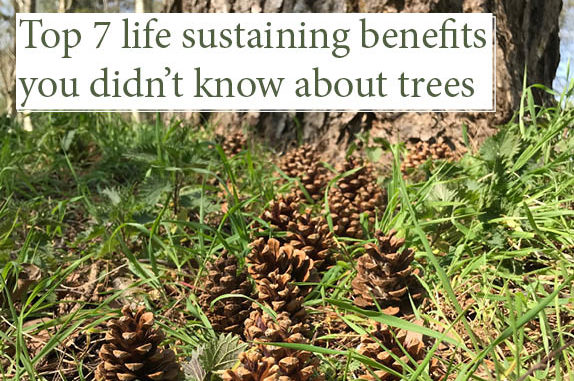
Top 7 life sustaining benefits you didn’t know about trees
With links to references
According to the World Resources Institute, nearly 80% of the world’s old growth forest has been cleared[i]. Forests now cover only 6% of the planet, but they harbor up to 90% of the world’s terrestrial biodiversity[ii]. Scientists are encouraging the world to refocus on the critical role of trees to mitigate climate change[iii]. Here’s some of the latest science explaining why.
1 Forests support the water cycle we need for our future harvests
The healthy function of weather patterns in the upper atmosphere[iv] relies on trees[v]. We need lots of forest cover to maintain the global rainfall cycles that support growing crops[vi]. Put simply, forests ensure food for our children[vii].
2 Trees medicate and heal the atmosphere
Trees don’t just breathe out oxygen. Tropical trees also release helpful aerosols that reduce the global warming effect of cow farts[viii]! They also contribute towards cloud seeding and building of the ozone layer that protects the Earth from the intensity of the sun’s rays[ix].
3 Trees breathe out aerosols that support human health
The research of forest medicine expert, Dr Quing Li, an environmental immunologist, demonstrates that each minute we spend near trees lowers our levels of adrenaline and cortisol, the stress hormone[x]. Trees release airborne substances that protect them from insect and microbe attack. We breathe them in and they help us too.
4 Forests draw down carbon
Tree planting (along with soil regeneration), are vital to drawing down carbon emissions into the land. The latest International Panel on Climate Change report states that with sufficient investment, trees could be drawing down over 30% of our annual carbon emissions[xi]. Scientists are now revising this to say that with adequate investment, we could cancel out a decade of human carbon emission[xii].
5 Forests feed and protect ocean life
When forest mulch drains through our waterways into the ocean, it feeds plankton and sea kelp forests with fulvic acid, a form of iron that ocean life depends on[xiii]. The plankton and sea kelp then support other ocean life such as fish. Hence in Japan there is a saying ‘if you want to find a fish, climb a tree”. This remarkable relationship gives us a guide to where to re-plant trees, so that we can replace the 40% forest cover loss around global rivers.
6 Trees medicate our waterways
Aspirin comes from willow trees. The salicylic acid in willow bark is water soluble[xiv]. Therefore, the willows along our waterways leach anti-inflammatories into the water, benefiting aquatic life[xv]. Trees support our waterways to be life-giving and life-supporting in countless ways.
7 Forests provide a road map for human future well-being
Trees need healthy soil, clean air and good water. So do we. By attending to the needs of forests, we also take care of our own health.
What we do know is that if predicted climate change happens, it will have dramatic and long lasting effects for the trees and forests we need to survive and thrivei. It is for all the above reasons and a myriad more that TreeSisters and their global network of collaborative partners are focused on reforestation and earth regeneration, funding community enhancing planting projects across the Tropics and globally[xvi].
[i] Food and Agriculture Organisation of the United Nations. 2018. The State of the World’s Forests 2018 – Forest pathways to sustainable development. Rome.
http://www.fao.org/3/I9535EN/i9535en.pdf
[ii] The World Bank, World Forests at a Glance. https://siteresources.worldbank.org/ESSDNETWORK/64158610-1111583197441/20488129/BiodiversityAndForestsAtAGlance.pdf
[iii] Federici, S., Lee, D. and Herold, M. (2017). Forest Mitigation: A Permanent Contribution to the Paris Agreement.
[iv] Video of Rossby wave from the Ocean Service https://oceanservice.noaa.gov/facts/rossby-wave.html
[v] Ellison et al., 2017. Trees, forests and water: Cool insights for a hot world https://www.sciencedirect.com/science/article/pii/S0959378017300134
https://journals.ametsoc.org/doi/full/10.1175/2011JAS3686.1
[vi] Biotic Pump theory, A.M. Makarieva 2017
https://www.tandfonline.com/doi/abs/10.1080/16000870.2016.1272752
[vii] Ellison et al., 2017. Trees, forests and water: Cool insights for a hot world https://www.sciencedirect.com/science/article/pii/S0959378017300134
UNEP Article: https://www.unenvironment.org/news-and-stories/story/im-proud-have-brought-rain-back-reforestation-revives-cambodian-mountains
Met Office, Sanderson et al. 2012 Relationship Between Forests and the Weather http://ec.europa.eu/environment/forests/pdf/EU_Forests_annex1.pdf
How deforestation is affecting global water cycles
https://e360.yale.edu/features/how-deforestation-affecting-global-water-cycles-climate-change
[viii] Sharkey, T et al. 2007, Isoprene Emissions from Plants: How and Why https://academic.oup.com/aob/article/101/1/5/91716
[ix] United States Environmental Protection Agency https://www.epa.gov/ghgemissions/global-greenhouse-gas-emissions-data
[x] https://treesmendus.com/tree-aerosols-boast-health/ – work of Diana Beresford-Kroeger and Dr Quing Lee
[xi] This figure is derived from the IPCC’s upper limit of carbon sequestration through aforestation and reforestation (3.8 gigatones of carbon per annum) and our current annual global carbon emissions (37.1 gigatonnes CO2 pa which equates to 10.1 giga tonne of Carbon pa). Where 3.67 tonnes of carbon dioxide converts to 1 tonne of carbon.
[xii] https://www.independent.co.uk/environment/forests-climate-change-co2-greenhouse-gases-trillion-trees-global-warming-a8782071.html
[xiii] Marine Chemist Professor Katsuhiko Matsunaga http://calloftheforest.ca/people/
[xiv] https://www.encyclopedia.com/medicine/encyclopedias-almanacs-transcripts-and-maps/white-willow
[xv] From the research of Diana Beresford-Kroeger https://www.amazon.co.uk/gp/product/0472051148/ref=dbs_a_def_rwt_hsch_vapi_taft_p1_i2
[xvi] TreeSisters Reforestation program https://www.treesisters.org/home/trees
